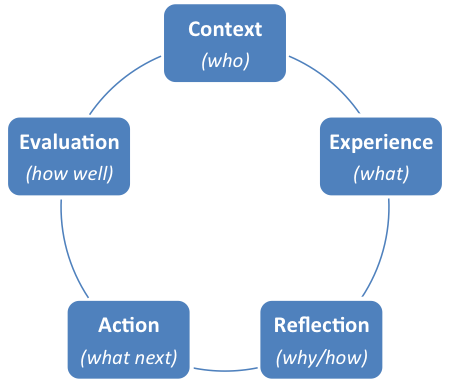Ignatian Pedagogical Paradigm
The concept of Ignatian pedagogy derives from the underlying principles, values, and actions realized in the Spiritual Exercises of St. Ignatius of Loyola, founder of the Jesuits. During the Exercises, a retreatant (who is, in essence, a learner) is guided through a process of reading, reflection, and prayer by a spiritual director (who is, in essence, a teacher).
The director guides the retreatant through a series of sequenced activities that rely on contemplation, repetition, and reflection as a process for deepening one's experience and understanding of God (click the following link for more on Ignatian spirituality and the Spiritual Exercises: link). The framework of Ignatian pedagogy, then, takes the general principles and approach of the Ignatian Spiritual Exercises and translates them into a process for educational practices more generally.
This section provides an Overview of Ignatian Pedagogy, as well as additional resources and examples of Ignatian pedagogy in action.
For more resources on Ignatian pedagogy, please click here.
Ignatian Pedagogy - An Overview
Every faculty member at a Jesuit institution finds her own way to connect to her university's
particular mission. Whether or not this connection is rooted in shared religious belief,
it is at least minimally connected to the Jesuit commitment to the transformational power of education. This commitment manifests itself in various ways, from community-based service learning
to addressing social justice issues in the classroom to cura personalis (Latin for "care of the whole person") in our dealings with students.
One way faculty can connect to the larger mission of Jesuit education is to be intentional
about using the Ignatian Pedagogy Paradigm to shape students' learning experiences.
The five elements of Ignatian pedagogy - context, experience, reflection, action, and evaluation - derive from the underlying principles, values, and actions in St. Ignatius's Spiritual
Exercises. They can inform a course implicitly (e.g., in the instructor's orientation
toward his students) or be used explicitly to frame the course (e.g., in the course
syllabus). Whether we call them "Ignatian" or not, research on learning confirms that
these are the conditions for learning.
Ultimately, the elements of Ignatian pedagogy offer a way of understanding how deep,
transformative learning occurs. The figure below offers a snapshot of how the process
works:

All learning is . . .
Situated in a specific context.
Rooted in previous experience and the result of new learning experiences.
Dependent upon - and deepened by - reflection about those experiences.
Made meaningful when new knowledge is put into some kind of action.
Reinforced by explicit evaluation (and ultimately, self-evaluation) of those actions and the degree to which learning has occurred.
Ultimately, these elements should be understood as representing a process, not a prescription, for teaching. (Thanks to Michael Rozier, S.J., and Darina Sargeant, Ph.D., for this distinction.) They function not as discrete segments or stages of a linear process, but as interdependent facets of any deep learning experience.

















